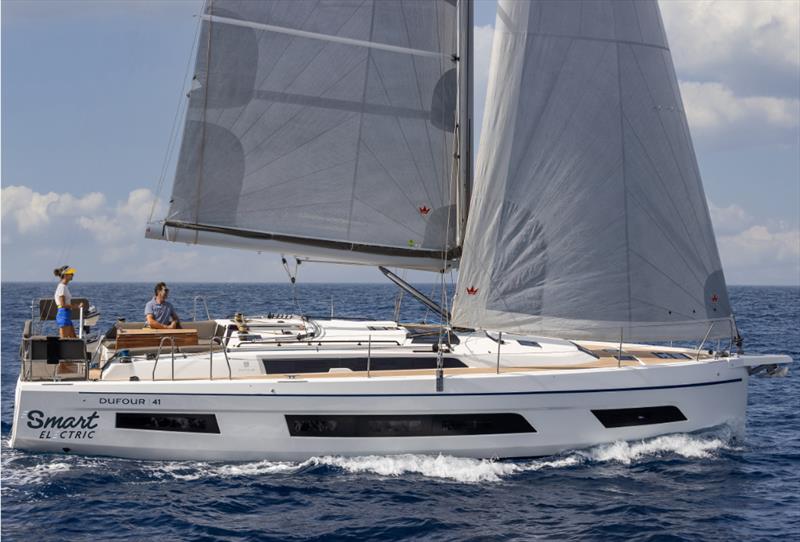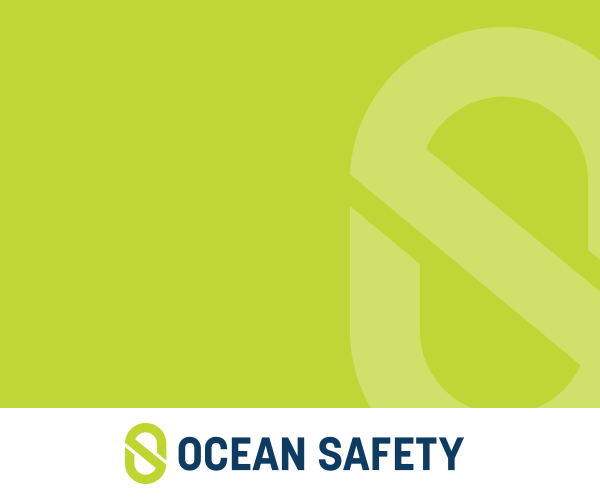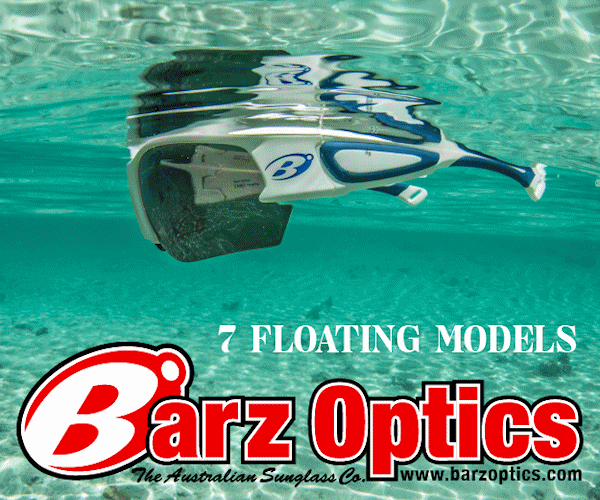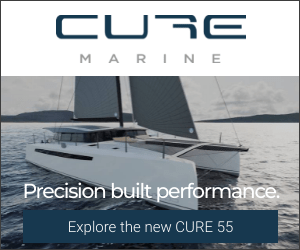
Dufour Smart Electric: Renewable energies for a sustainable boat - photo © Dufour Yachts
Dear Recipient Name
A not insignificant amount heavier, and maybe 15-20% more expensive. Sounds a lot more like a large drogue, rather than a ride along a travelator at a huge airport. Sure, but like all things, it is a matter of perspective. So, are you looking at the wire mesh fence, or have you stepped right up to it, and are now peering through the very gaps themselves?
Recently, we grabbed a lot of material from Fountaine-Pajot/Dufour along with Alternative Energies, and then our Managing Editor, Mark Jardine, attended a briefing in the UK about their hybrid offering.
In conversation afterwards, Mark and I ended up with one word that best described their hybrid offering: Pragmatic. Might not be a word that will get the marketers running to the fridge to get the Champagne and caviar out, but as yachties, it has got that real world, thought through, kind of air about it.
'Smart Electric', as it is known officially, is not new news as such (we ran our first piece on it in 2022), but unlike the millions of 3D renders floating around, and press releases about new-fangled this, or defying the laws of physics that, 'Smart Electric' has got traction, and even more importantly, take up!
Yes. There are boats out there with it! WoooHooooooooo.
So why have we got the entire horn section of the big band blasting away now?
- Well, firstly, we liked how Fountaine-Pajot/Dufour went outside the traditional industry to develop the solution, and even more importantly do so in an expeditious manner.
- Secondly, it has stood the test of time in a technology space that probably has the calibration marks on the timeline recorded in months, not years.
- Thirdly, it adds to the whole sailing experience.
- Fourthly, it is safe.
- Fifthly, there is an impressive 10-year guarantee on battery life still being at 80% at that point.
- Then finally, Fountaine-Pajot/Dufour are not squirrelling it away solely for their own use, they are offering it to the industry as a whole (BTW, Leopard have already embarked on this specific path).
These are some significant arrows to have in your quiver.
One other thing. Some of the charter companies have gone in for it, as they believe the payback is around five years. Most of this is a result of the significantly lower annual maintenance costs, and of course, the fuel itself. Je voir. Je voir.
Yes. We have stepped right up to that wire mesh fence now. So much so that your nose is kind of getting squashed.
Now Mark and I pondered before the event, and then assessed it all afterwards, which is when Mark even suggested that 'Smart Electric' was, "The best hybrid solution I've seen so far for a standard cruising yacht." How about them apples, huh?
Mark added, "During times of transition we often see very different approaches to a problem. Some put their chips 'all in' for a single technology, while others will be evangelical about another. As things stand, there isn't any one ideal solution, and the Alternatives Energies approach recognises that, using their 27 years in the industry to take a pragmatic, hybrid approach to greener energy consumption on board a cruising yacht.
"Their answer is electric-only for much of the time, while also having the diesel genset backup when needed. 'Smart Electric' shows what can be done to make cruising greener, but also quieter."
As for me, well I cannot say I was not circumspect, for I most certainly was. Yet the whole thing was categorically the genesis for this here ditty, however.
Now in a monohull, 'Smart Electric' adds in something like 200kg more displacement, and yet the vessel has no extra sail plan to account for it.
Equally, hydro-regeneration knocks maybe 0.5 knot or so off the boat speed (at this level), and cruising boats do not have that much to hand off in the first place. These, and other critical aspects cannot be waved away like you are the late Sir Alec Guinness surrounded by a few clone soldiers. No, no, no.
Still. There is enough there go for a dig, so it was time for the pick and shovel...
Now when you are delivering power from an ICE generator, solar, wind, hydro, also of course shore when you are there, and your consumers are thrust, along with then the house for both DC and AC requirements, it is a complex arrangement. Voltage, amperage, load, drain, transformation and inversion are all playing out at the one time, and in a constant flux (pun intended) as to the various requirements of each at any one point in the equation.
You need a brain for that, which is exactly what 'Smart Electric' has. It is called EPMS (Energy Power Management System, so clearly it was the Engineers who named that, not the Marketers), and it is the product of Alternative Energies, who have amassed 27 years working with the Merchant Marine, and those vessels utilising their tech have carried over 20 million passengers, they have 75 systems in place, and now in the last few years have also evolved into recreational boating. They were acquired by Fountaine-Pajot/Dufour in 2022.
Highlighting the thoroughness that we mentioned earlier, Alternative Energies' own, custom designed and built, water-cooled pod underneath the hull also mounts to an existing sail drive slot, with a three-bladed screw that is optimised to each vessel type.
Jérémy Benichou from Alternative Energies is the driving force, quite literally, behind the development of 'Smart Electric'. He's actually the answer to the very first question I proposed ahead of the briefing. Namely, "At what point do the electronics work it all out, and according to whom?" He's also an avid sailor, and passionate about that, and this project.
Here's a bit of quick-fire response time from Jérémy to draw out some salient points:
- Hydro-regeneration delivers 1.8kW at 7 knots, with half a knot lost through drag, but this is off the breeze, naturally. Now whilst it's not as efficient upwind, it still generates, and Jérémy is quick to point out that true upwind sailing only accounts for a small amount of actual cruising time.
- Jérémy quickly adds, "So when you sail Dufour 470 for 10 hours at 7 knots, you make enough energy to be able to then steam for 3 hours at 6 knots."
- One also needs to note that should the breeze crump, or take the apparent even higher, when making passage you'll still be able to hold some sort of pace and COG, which can be such a value add. Make sure the Chablis is in the fridge. You'll make the anchorage that night.
- Equally, take into account that this travel is silent, drawing also from solar and wind turbine in addition to the sails, and battery, with the genset not a mandatory aspect of the equation. I believe we just said motor-sailing. Can you believe it? I'll be up for heresy. Grab your bag of stones...
| |

|
|

|
| |
- Battery stores enough for house loads for up to 24 hours of normal use. i.e. Quiet nights at anchor with no smelly running. Jérémy says the best option is 27kwh bank with 400W of solar for recharge. Also maintaining things at between 20 and 80% is best for overall battery life, which is part of the EPMS' job.
- Also offers up to 18 hours of silent propulsion needs (say 30-40nm), with instant power and higher torque part of the benefits on tap, which in tide, wind or docking scenarios are better than nice to have.
- LiFePO4 (Lithium Iron Phosphate) battery, which is why there is that 10-year guarantee on the battery still being at 80% at that time. For what it is worth, I always tell people that batteries with 'LiFe' in the name are good for keeping you in that state of being, as it is really hard for them to have a thermal runaway event.
- 5000 cycles of charge/discharge with this system.
- N.B. In-built fire suppression system with foam, and the engine can be run without the battery, so you have redundancy. Read ICE to the fore there...
- The EPMS brain is connected by a dedicated satellite SIM for monitoring, software updates and smart learning, which is not AI, but using collective data to improve the software. Naturally, this is an opt-in requirement by the owner.
| |

|
|

|
| |
- HVIL high voltage interlock loop 300 at 300V, with step down transformers for 240 and 12V, and I would imagine 110V if you wanted it. There is an air-cooled 'one box' arrangement for termination of all wiring. AC Inverter, AC/DC converter, propulsion variator, DC/DC converter and bus are all housed here. It all uses the traditional engine room space (along with the 16kW genset that runs autonomously under the instruction of the EPMS), and the EPMS is in a separate box, but co-located. In the monohulls, the batteries are located closer to Centre of Buoyancy for the obvious reason.
- Greater Freedom/Autonomy. There is 30-50% more range on offer with same fuel capacity as before. The genset is 15% more efficient by virtue of being a smaller powerplant to begin with (possibly 30% so), and running at the specific load/RPM to match the draw requirements.
- Lower maintenance, with engine seal replacement carried out at 1500 hours, and then the manufacturers requirements for the genset.
- Caribbean charter company has done the analysis with the payback period being five years as compared to a conventional diesel arrangement.
- There is a brilliant MFD interface as well.
- There are twenty Fountaine-Pajot and Dufour vessels thus equipped to date, with three Leopards completed or in-build. As it is not a major alteration to the vessel, it is not that onerous to reconfigure from a tradition ICE setup, which is good for production style vessels.
- Note that the charter companies are yet to take delivery of theirs, but it starts soon and will effectively double those tallies in rapid time.
During our conversation, Jérémy often commented about how this was all about enhancing the sailing experience. So whilst you could focus on the added displacement actually hampering the cause, this would pay no deference to the fact that adding electricity into the power mix delivers these core benefits. Namely, range, more usability due to silent and vibration free motor-sailing (God! I have said it again...), and then live in peace and quiet more often, and for longer spells whist you're at it.
The latter stipulation is arguably the hardest and most expensive to achieve, and would probably be what most owners say was the driving force behind going cruising in the first place.
That you have significantly higher house loads on modern vessels over those of days gone by, and the intelligent management of the 'Smart Electric' system means you are not doing it, just observing and enjoying the outcome, would undoubtedly play into the R&R card, magnificently. Load up the stores, cast off the lines, and away you go - both further afield and for longer durations, as well. Add in safety, and you may well have the magic mix.
No need to bake, just take it out of the box and consume it. Me thinkey that's very on trend. Just saying...
'Smart Electric' will not be for everybody. Jérémy is quite clear about it being for those who want the autonomy, and not be fixated on SOG and polars. Or, as we say, it is for those who want to sail in more conditions, travel further and stay longer. It's here and now, proven and reliable, pragmatic and ingenious, with a lower ultimate cost structure to boot.
Given how everybody wants to escape the norm, that's an expanding market, and that's smart...
OK. We have stories, lessons, inspirations and history to regale yourself with on the website. Please use the search window at the top of the home page if you are after something specific, as only the latest news appears on the site as you scroll down. We enjoy bringing you the best stories from all over the globe.
If you want to see what is happening in the other Hemisphere, go to the top of the SailWorldCruising home page and the drag down menu on the right, select the other half of the globe and, voila, it's all there for you.
Finally, stay safe, and let's see where it all goes now,
John Curnow
Global Editor, SailWorldCruising.com
|